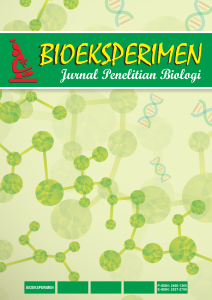Karamunting Leaf Extract (Rhodomyrtus tomentosa (Aiton) Hassk.) as antibiofilm on Escherichia coli
DOI:
https://doi.org/10.23917/bioeksperimen.v11i1.10815Keywords:
Karamunting, extract, Eschericia coli, antibiofilmAbstract
Escherichia coli is a bacterium that causes many serious infections such as digestive tract, urinary tract and bloodstream infections. One of the main challenges in treating this bacterial infection is the formation of biofilm, which increases bacterial resistance to antibiotics. As an alternative to overcome antibiotic resistance, karamunting has been identified as having antibacterial potential against Gram-negative bacteria, including E. coli. The active compounds in these leaves have been shown to inhibit bacterial growth and biofilm formation. This research describes the activity of karamunting leaf extract against the anti-biofilm E. coli. The thick karamunting leaf extract was then made into three variations of concentration, namely 125µg/mL, 250µg/mL and 500µg/mL. The parameter measured for the eradication test is the thickness of the biofilm which is read using the Elisa Reader 590nm. In this study, the eradication percentages for the three concentrations were obtained -92.15% at a concentration of 125 µg/mL, -187.24% at a concentration of 250 µg/mL and 52.78% at a concentration of 500 µg/mL. Karamunting leaf extract has activity as an antibiofilm against E. coli bacteria. Karamunting leaf extract with a concentration of 500 µg/mL is the Minimum Inhibitory Concentration (MIC) which is effective as an antibiofilm on E. coli.
Downloads
References
Bria, D. I., Missa, H., & Sombo, I. T. (2022). Isolasi dan karakterisasi bakteri Escherichia coli pada bahan pangan berbasis daging di Kota Kupang. JUSTER: Jurnal Sains Dan Terapan, 1(2), 82–89.
Dwicahmi, P. (2015). Uji Aktivitas antibakteri ekstrak etanol 70% daun karamunting (Rhodomyrtus tomentosa (Ait.) Hassk) terhadap pertumbuhan bakteri Vibrio cholerae secara in vitro. Jurnal Mahasiswa PSPD FK Universitas Tanjungpura, 3(1).
Freeman, J. T., Anderson, D. J., & Sexton, D. J. (2009). Seasonal peaks in Escherichia coli infections: possible explanations and implications. Clinical Microbiology and Infection, 15(10), 951–953.
Hujjatusnaini, N., Amin, A. M., Febrianty, R., Maisyarah, A., Agriana, B. M., Septianingrum, D. D., Maradona, M., Wulandari, N. S., & others. (2022). Perbandingan kemampuan adaptasi bakteri Staphylococcus aureus dan bakteri Escherichia coli pada ekstrak daun karamunting (Melastoma malabathrium). BIOSEL (Biology Science and Education): Jurnal Penelitian Science Dan Pendidikan, 11(1), 96–104.
Hutomo, S., Anggreni, N. W. R., Larope, C. G., Trismalinda, N. W. M. P., Sari, N. K. A., & Sooai, C. M. (2023). Kemampuan ekstrak etanol daun kelor (Moringa oliefera) dalam menghambat pembentukan biofilm Escherichia coli: The inhibitory activity of kelor (Moringa oliefera) leaves ethanolic extract on Escherichia coli biofilm formation. Biomedika, 53–60.
Iavicoli, I., Fontana, L., Agathokleous, E., Santocono, C., Russo, F., Vetrani, I., Fedele, M., & Calabrese, E. J. (2021). Hormetic dose responses induced by antibiotics in bacteria: A phantom menace to be thoroughly evaluated to address the environmental risk and tackle the antibiotic resistance phenomenon. Science of the Total Environment, 798, 149255.
Jang, J., Hur, H.-G., Sadowsky, M. J., Byappanahalli, M. N., Yan, T., & Ishii, S. (2017). Environmental Escherichia coli: ecology and public health implications—a review. Journal of Applied Microbiology, 123(3), 570–581.
Kırmusaoğlu, S. (2019). The methods for detection of biofilm and screening antibiofilm activity of agents. In S. Kırmusaoğlu (Ed.), Antimicrobials, Antibiotic Resistance, Antibiofilm Strategies and Activity Methods. IntechOpen. https://doi.org/10.5772/intechopen.84411
Kobayashi, T., Ikeda, M., Okada, Y., Higurashi, Y., Okugawa, S., & Moriya, K. (2021). Clinical and microbiological characteristics of recurrent Escherichia coli bacteremia. Microbiology Spectrum, 9(3), e01399--21.
Martinson, J. N. V, & Walk, S. T. (2020). Escherichia coli residency in the gut of healthy human adults. EcoSal Plus, 9(1), 10–1128.
Paramanandana, A., Retnowati, D., Miatmoko, A., Isadiartuti, D., Rijal, M. A. S., Setiawan, D., Hendradi, E., Purwanti, T., Rosita, N., Hariyadi, D. M., & others. (2019). Pendidikan kognitif dan afektif DAGUSIBU untuk pencegahan resistensi antibiotik di SMA Surabaya. ABDIMAS TALENTA: Jurnal Pengabdian Kepada Masyarakat, 4(1), 97–102.
Pratiwi, R. H. (2017). Mekanisme pertahanan bakteri patogen terhadap antibiotik. Jurnal Pro-Life, 4(3), 418–429.
Purnama, S., Indrawati, A., Wibawan, I. W. T., & Rizkiantino, R. (2022). Korelasi virulen gele dan pembentukan biofilm pada isolat Enterococcus faecalis yang diisolasi dari ayam pedaging. Acta Veterinaria Indonesiana, 10(2), 157–163.
Sabrina, T., Kamaluddin, M. T., & others. (2021). The effectiveness of karamunting leaf’s fraction (Rhodomyrtus tomentosa (aiton) hassk) as antimicrobials in carbapenemase resistant Klebsiella pneumonia. Sriwijaya Journal of Medicine, 4(1), 1–8.
Sharma, G., Sharma, S., Sharma, P., Chandola, D., Dang, S., Gupta, S., & Gabrani, R. (2016). Escherichia coli biofilm: development and therapeutic strategies. Journal of Applied Microbiology, 121(2), 309–319.
Song, T., Duperthuy, M., & Wai, S. N. (2016). Sub-optimal treatment of bacterial biofilms. Antibiotics, 5(2), 23.
Tjampakasari, C. R., & others. (2021). Patogenesis dan virulensi Burkholderia pseudomallei penyebab melioidosis dan Burkholderia cepacia sebagai patogen oportunis. Jurnal Biomedika Dan Kesehatan, 4(1), 27–36.
Vila, J., Sáez-López, E., Johnson, J. R., Römling, U., Dobrindt, U., Cantón, R., Giske, C. G., Naas, T., Carattoli, A., Mart’inez-Medina, M., & others. (2016). Escherichia coli: an old friend with new tidings. FEMS Microbiology Reviews, 40(4), 437–463.
Downloads
Submitted
Accepted
Published
Issue
Section
License
Copyright (c) 2025 Bioeksperimen: Jurnal Penelitian Biologi

This work is licensed under a Creative Commons Attribution-NonCommercial 4.0 International License.












